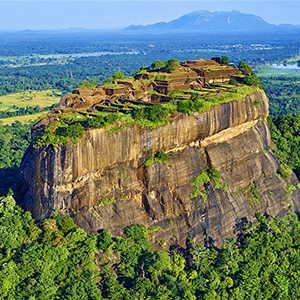Exploring Sigiriya: Ancient Sri Lankan Fortress Beckons with History and Beauty, but Rising Entry Costs and Accessibility Challenges Spark Visitor Feedback
- SRI LANKA SERIES – 5
- BILKULONLINE
By Rafat Quadri
Ahmedabad, Nov 12: Sigiriya Rock, also known as Sinhagiri (Lion Rock), is a UNESCO World Heritage site in Sri Lanka that is important for its historical, cultural, and architectural significance.
Sigiriya is a symbol of national pride and a testament to Sri Lanka’s rich heritage. The site was built in the late 5th century CE by the Sinhalese king Kashyapa I, who intended it to be a defense against his enemies.
Sigiriya is a popular cultural destination known for its frescoes, mirror wall, and lush gardens. Visitors can hike to the top of the rock through the open paws of the lion, one of the few remaining portions of the palace.
The distance from the Colombo is 169km and is on the way to Anuradhapura or polonnaruwa. Sigiriya was designated as a world heritage site in 1982. Sigiriya is famous for it’s palace ruins on top of a massive 200 meter high rock surrounded by the remains of an extensive network of gardens, reservoirs and other structures.
The rock itself is a lava plug left over from an ancient long extinct volcano. It is also renowned for its ancient paintings (frescoes), which are similar to those found at Ajanta Caves in India. It is generally agreed, however, that the Sigiriya Frescoes exhibit a uniquely Sri Lankan style. Sigiriya may have been inhabited through prehistoric times.
It was used as a rock-shelter mountain monastery from about the 5th century BC, with caves prepared and donated by devotees of the Buddhist Sangha. Sigiriya Museum shows photos of the excavation of Sigiriya, reproductions of the frescoes, examples and translations of some of the graffiti on the Mirror Wall, and artifacts excavated from the site. You can probably view the museum in about 1 hour. Since the museum is outside the main entrance.
Sigiriya is connected to the city of Dambulla by a regular bus service. These buses run between 6:30AM to 6:00PM every day at intervals of 30 minutes and cost LKR40. Travel by tuk-tuk from Dambulla is LKR800-1000. It is important to note that Sigiriya is located about 25 km from Dambulla, the closest city, and it is recommended not to miss the last bus back to Dambulla at around 6:00PM in case you are not staying at Sigiriya itself.
Buy or take water with you before you enter the paid area. It’s a long climb, and you will sweat and become very thirsty. Water and drinks are not sold inside, and are available only at the “tourist exit”. Due to the length of the climb, also take a hat for protection against the sun. To avoid the heat, get as early a start as possible and head straight for the rock. Biscuits and chips can be bought in the shack near the place where passes to the site are sold.
We the media group from Gujarat, India on our visit to Sigiriya at the invite of Sri Lanka Convention Bureau found this world heritage site as one of the rarest find. However, we had two humble suggestions one, the ticket of entry was slightly at higher end, two there can be a ropeway type of arrangement made from the hill top for the senior citizens and unfit visitors to this unique site.
(Rafat Quadri can be contacted at editorbilkul@gmail.com)
Visit our You Tube Channel link for this story and more and kindly Subscribe.
